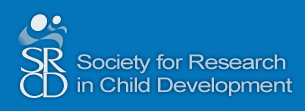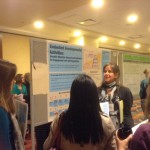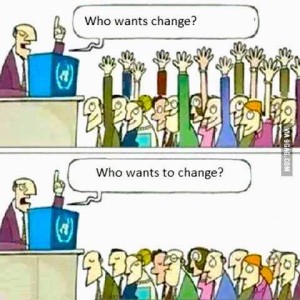SRCD Developmental Science Teaching Institute
EMBODIED DEVELOPMENT

 Catherine Rosasco Mitchell and Carolyn Palmer
Catherine Rosasco Mitchell and Carolyn Palmer
We got invited to do a poster presentation at the Society for Research for Child Development (SRCD) and Carolyn Palmer, Vassar College researcher and Catherine Rosasco Mitchell
Twenty-two posters were displayed in our session and presenters had an hour and a half to talk to interested spectators. After talking to many people I stood back to take a breather and looked around the room. All the other posters and people were gone except us? People were still there talking to us long after the session ended. People were interested in Embodied Development–how the body influences ambition, perception, confidence, inhibition and attention.
“Want to feel a somatic sense of self-awareness?” The poster presentation started with an experiential example of how to sense the character of the mind in motor-patterns. Then we  shared fundamental questions about development, for example: “Does embodiment play a role in development?”; “What would be different in the outcome if lesson plans included sensory self-awareness?”; and “What kind of sample lesson could teachers do for sensory self-awareness?”
shared fundamental questions about development, for example: “Does embodiment play a role in development?”; “What would be different in the outcome if lesson plans included sensory self-awareness?”; and “What kind of sample lesson could teachers do for sensory self-awareness?”
The poster how embodied awareness influences learning showed differences in the learner when the children feel “Here I am” . Sharing gave viewers “Lessons” (for example the Get Sensational Attention (GSA) program) to enhance academic lesson plans. (Also see the talk”Unorthodox Inquiry in the science & Math Classroom: Meet the Feldenkrais Method”LINK) “Embodied Development” was a familiar and exciting concept for professionals in the Psychology, Development, and Neuroscience fields but how to feel it and teach it was new to most. Poster_Embodied Development _4-2. Hand out LINK
One of the most valuable and thought provoking comments came before the conference from Brown University professor, Kathy Kerr. We talked about how learning the effects to embodied awareness will change both healthcare and education social systems. She expressed how important it was to reach the community through research. If we didn’t, it would be some time before this research could benefit people. We brainstormed ideas for experimental measures and the possibilities of connections between the immune system and embodied awareness.
Related Research with Sensory Motor Learning
Other researchers are starting to collect data related to how the body influences the brain and perception. At the SRCD main conference these were a few of those researchers worth mentioning: James P. Curley, Rahia Mashoodh, Cate Jensen, Emily Jordan, Zoe Donaldson, Marija Kundakovic, and Kathryn Gudsnuk from Columbia University are looking at stress response, social behavior, learning and memory; Carla Calvin and Karen Bierman from Pennsylvania State University are looking at interpersonal coping skills; George F. Michel from University of North Carolina at Greensboro is looking at motor development and psychological development; and Melissa Clearfield and her team from Whitman College are studying behavior, posture and communication to cognitive development. And the most impressive research was Nina Leezenbaum and her team from University of Pittsburgh who are looking at physical posture and movement to detect early signs of autism.
If you are doing research in the field of the physical embodiment and cognitive development please contact SRCD. This conference attracts researchers world wide.
These were the studies presented just in the first day of a five-day conference, with over 10,000 people in attendance. The SRCD catalog had over 300 pages devoted to presentations so I’m sure there were more studies but only three that caught my eye explored the depths of how embodiment influences the brain.
Professor Karen Brakke however may be also making a difference by breaking ground for this new concept of reaching communities by including cutting edge research in University curriculum. We sat in a round table discussion with her and about 20 others and discussed a project initiated by editor of SRCD Monographs and the SRCD Teaching Committee. The intention of the project is to form a board to establish guidelines for Development curriculum at the University levels of education. One of the most important roles Universities must take is the responsibility is to share cutting edge research in development. “Embodiment” is cutting edge research. It is at the Universities most communities find out about new concepts. Guidelines will take shape in the coming year once Brakke takes sabbatical so stay tuned! We are staying in touch.
So Many Mahalos (Thank You)!
Mahalo to all people we know (and don’t know) working towards this kind of change in education. A special thanks to co-creator of the presentation Carolyn Palmer, our lone donor Duncan Dempster toward the trip, to IT person Andriy Yankovskyy from the Ukraine for the graphics in the poster, and most importantly to the Society for Research in Child Development Conference Teaching Institute. I also want to thank the North Hawaii Community Resource Center again for stepping forward as our fiscal agent.
Together we go taking tiny steps towards change in the infrastructure of education… from the bottom up… to the heart and soul of how children think.
Closing Thoughts
 If you haven’t heard, the NEW Video animation lesson will be available free for elementary schools in a couple of weeks on YouTube. Please sign up on our mailing list if you would like us to send you the link. Double link: Contact Wellness Through Movement
If you haven’t heard, the NEW Video animation lesson will be available free for elementary schools in a couple of weeks on YouTube. Please sign up on our mailing list if you would like us to send you the link. Double link: Contact Wellness Through Movement
One thought on “SRCD Poster Presentation”
Comments are closed.